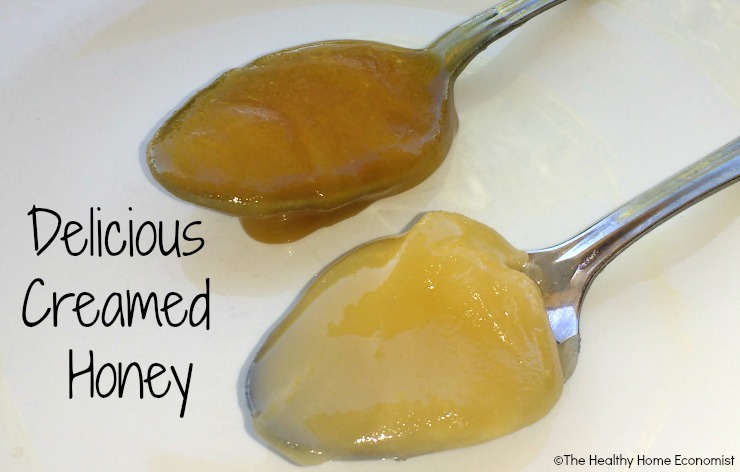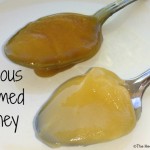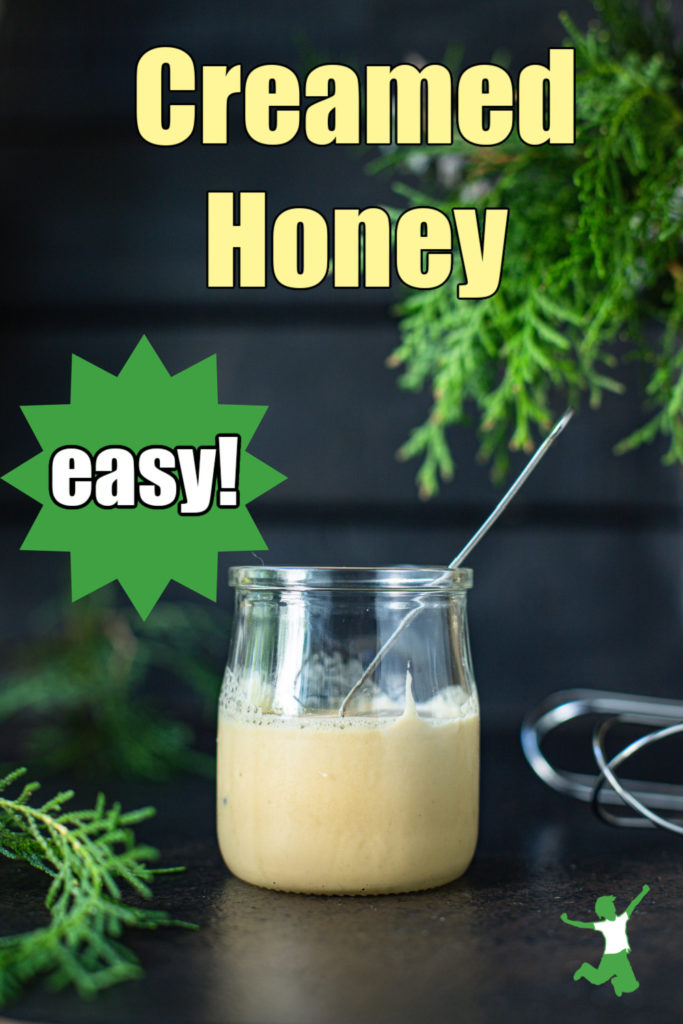How to make creamed honey at home inexpensively and easily that is thick and delicious right off the spoon or spread on your favorite baked goods.

Creamed honey is considered the crème de la crème of raw honey for good reason with a powerful nutritional profile as well as a luscious texture. Making it yourself from raw liquid honey is easy, but never ever whip it!
Consumers consider creamed honey the crème de la crème of raw honey. Often, retailers and wholesalers sell it at a premium price. This is the case no matter whether plain or flavored. Purchasing directly from a local beekeeper or off the shelf at the health food store is still a pricey endeavor.
From a practical standpoint, I prefer creamed honey to liquid honey. This is because its thickness makes less of a mess in the kitchen when the kids are making breakfast or grabbing a spoonful after school.
No sticky drips on the floor, table, or counters to clean up!
From a nutritional point of view, consumers often assume that the premium price of creamed honey indicates a healthier product. This is especially true if flavored with herbs or fruit.
Another common misconception is that whipping liquid honey like butter transforms it into creamed. Adding air to the honey is incorrectly assumed to achieve that delectably smooth texture that is so enjoyable off the spoon or infinitely spreadable on toast.
Is either of these assumptions actually true? Is it possible for honey fans to easily make creamed honey at home from less expensive but just as nutritious, local liquid honey? This would certainly save money! DIY creamed honey would also allow for unique flavor combinations or just to enjoy a fun project with the kids.
Is Creamed Honey More Nutritious or Beneficial?
Many fans are surprised to learn that creamed honey does not confer any additional health benefits compared to liquid honey. There is no difference in terms of quality, nutrition, or natural antibiotic value. Of course, this assumes both are completely unheated and unfiltered.
Texture and thickness are ultimately the only differences between creamed and liquid honey. However, consumers willingly pay more for creamed honey simply because of the dreamy, spoon-worthy texture.
For example, the amazingly delicious, creamed honey we use comes from a variety of organic beekeepers in the United States, Canada, Brazil, and New Zealand (source). It’s a bit pricey, but my kids absolutely love it because it is ultra-thick, mild-tasting, smooth and spreadable. When using raw honey medicinally, however, I prefer seasonal local honey.
The picture above shows a spoon of local creamed honey and commercial creamed honey from the health food store. As you can see, creamed honey can vary quite a bit in thickness and consistency depending on the variety.
In my experience, local honey is more readily available in a liquid state when purchased directly from a beekeeper. Creamed honey usually comes from artisanal producers who might not live in your neck of the woods. Hence, the benefits of raw honey derived from the nectar of plants in your vicinity would be lost.
What if you could easily cream local raw honey purchased inexpensively and in bulk from a beekeeper? Wouldn’t you prefer this instead? I know I do! Here’s a video on sourcing the best raw honey I filmed to show you where to start.
How is Creamed Honey Made?
As mentioned above, a common misconception is that whipping liquid honey is the key to its transformation.
On the contrary, creamed honey is crystallized, not whipped like butter. Whipping liquid honey is actually very damaging as it introduces oxygen, moisture, and potentially pathogenic microbes into the mix. Do not do it! It is very destructive to this living superfood.
Whipping will also not produce quality creamed honey. Be wary of recipes that recommend this approach.
Creaming honey in a traditional manner is very simple. It is a low-temperature process used historically by beekeepers to slow down the natural crystallization of honey without damaging it in the process. If you’ve ever left a jar of raw, liquid honey in the pantry for a long time, you know what I mean. Large chunks of the honey crystallize naturally making pouring very difficult.
Crystallized honey can be re-liquefied by placing the jar in a pan of warm water not to exceed 117 ºF/ 47 ºC. In my experience, though, this is not a convenient process nor is it totally reliable. Larger chunks of crystallized honey do not readily liquefy in a reasonable period of time.
Instead of Creaming Honey, the Honey Industry Heats It
The modern honey industry found the natural crystallization process inconvenient too. The commercial solution is to heat treat honey on a large scale so that it would no longer solidify at all. This keeps industrialized honey looking presentable on store shelves for long periods of time. Of course, the expedient approach of heating honey destroys the enzymes, probiotics, and makes it toxic too. But, in the world of big business, this is inconsequential. Profits are most important to these corporations who figure most consumers don’t know any better.
Unfortunately, the honey industry has taken this dishonest attitude of “what the consumer doesn’t know, lines our pockets really well” an unsavory step further in recent years.
Most large scale honey manufacturers have replaced the honey either partially or entirely with honey-flavored corn syrup! To avoid this scam, you really must source your honey from a local beekeeper, small producer, or reputable retailer to be sure of authenticity. Buying honey from a large store or supermarket chains virtually guarantees that the honey is fake (1).
Be forewarned that according to a beekeeper friend of mine, many of the “tricks” to determine if honey is pure and raw are not actually reliable. The best approach is to read the label to ensure only honey is in the jar in the first place and buying from a reputable source to ensure a raw and unfiltered product.
Crystallized, Liquid or Creamed?
The good news is that like creamed honey, crystallized honey is just as high quality, flavorful and nutritious. This is the case even though large scale manufacturers and some consumers view it as a defect. You absolutely can eat crystallized honey, although the grittiness might cause you not to enjoy it as much. Some folks seem to prefer it. Factors which influence the rate at which raw liquid honey crystallizes include:
- Type of honey: some varieties granulate faster than others. You have probably noticed this if you are like me and keep many jars of different types of honey in the pantry.
- Temperature: Cold temperature speeds up crystallization considerably especially temperatures below 50 ºF/ 10 ºC. If you live in a warmer climate, you probably don’t have as much of an issue with crystallized honey. In warmer climates that regularly get into the 80’s ºF/ 30’s ºC or higher, honey remains runny much longer.
The upside is that if you notice your honey starting to crystallize, it is definitely raw. This is one way to know you’ve got the real thing!
How To Make Creamed Honey
A better solution to commercialized honey, however, is to buy quality raw, local honey.
Then, slow down the natural crystallization process by making it into creamed honey. This imparts a creamy smooth texture naturally. No whipping necessary!
Here’s how it’s done…

Creamed Honey Recipe
Easy recipe for transforming raw, liquid honey into delectable creamed honey.
Ingredients
- 2 cups raw honey must be liquid and unfiltered, preferably local
- 3 Tbl creamed honey crystallized honey may be substituted
- 1-2 tsp freshly ground cinnamon either Ceylon or Cassia, optional
- 1 wide mouth mason jar quart size
Instructions
-
If choosing crystallized honey as the starter for your creamed honey, it must be powdered into fine granules first. You can either use a mortar and pestle to do this, or buy crystallized honey powder instead.
-
Once you have your starter ready, pour the liquid honey into the mason jar. Slowly stir in the starter (either creamed honey or crystallized honey powder).
-
Do not whip or stir too vigorously as air introduced into the process will damage the integrity and flavor of the honey.
-
Continue to stir for about 2-3 minutes. Stir in optional cinnamon (I recommend 2 tsp of freshly ground Ceylon cinnamon and only 1 tsp if you choose the Cassia variety) for another minute or two.
-
Screw on the lid and place in a cool room or basement. The ideal storage temperature for creating creamed honey is about 50 °F/ 10 °C. If you live in a very warm climate, place the jar in a small cooler with an ice pack and change it once per day. Refrigerating will actually slow down the creaming process, so it is preferable not to do this unless it is the only option.
-
After a week or so, you might see a few bubbles forming on top or the color of the honey has become uneven. Like other fermented foods, every batch will tend to be a little bit different so be open to the possibilities Mother Nature has to offer.
-
The most noticeable changes are in the texture and clarity of the honey. It will no longer be clear and will take on a thicker consistency that is creamier and scoopable instead of pourable.
-
Store your creamed honey in the pantry. Avoid storing honey, creamed or not, for long periods of time near windows or on shelves near the stove, refrigerator or other appliances as warmer temperature can cause honey to become less flavorful.
Recipe Notes
If your home is very warm (over 90 °F/ 32 °C), you may wish to store the creamed honey in the refrigerator so it won’t get runny and darken in color. Don’t freeze it as this will change the texture although the nutritional value remains unaltered.
If your home is like ours, no worries as the creamed honey won’t last long enough for these problems to occur even during the hot summertime months!









I doubt that in the U.K. that anything in supermarkets labelled honey is anything but honey, it often says product of several countries, or UK honey. We keep bees, and it depends on what the nectar source is to how quickly it crystallises , oil seed rape for instance is very quick. We never heat ours, except for cooking, hot drinks. It’s just filtered, no-one wants bits of bee in their honey.
Creaming is done with a batch of last years creamed honey and is stirred in with a big stainless steel rod, the setting period depends on the temperature, cool is best. Apart from a few honeys, mainly from tree nectars most honey eventually crystalises. We don’t mind that but most people either want it very runny or creamy, thinking that large crystals means it’s going off, apart from being difficult to spread on anything ! Even creaming can introduce the odd bubble, these rise to the surface and are not an issue, honey doesn’t allow bacteria to survive.
Kind regards
I liked that you explained that the texture and thickness are the only differences between creamed honey and regular liquid honey. I would imagine that creamed honey would be less messy to use on toast or biscuits since it wouldn’t run off of your food. I will consider purchasing some creamed honey to see if it is a good alternative to the regular honey that I normally use.
Just learning about creamed honey. I thought I was a fan…but no longer. Last spring I bought two jars of honey from a local health food store. One was Y.S. Organic Bee Farms raw honey in an 8oz jar. This honey has a milky opaque look that caught my eye and seemed worth checking out. The other was a local beekeepers raw lightly filtered honey. It had the typical cloudy but slightly glossy appearance I was used to seeing in raw honey. I tried both honeys and thought they were great. The “creamy” Y.S. one definitely spooned out of the jar well and had a great texture. I knew I was going to enjoy using both products in teas and on biscuits and toast and as I determined which product I preferred. Fast forward past a long hot summer of cross-country moving with my items in boxes for weeks in a moving truck. It wasn’t until December that I began looking for my honey jars again, ready for the sweet and warming sensation of honey while outside the thermometer plummeted downward. What did I find? Of an approximately 5 cm high jar of “creamy” honey, where maybe half of one centimeter had been used, it was now the height of 1 cm and thick and glossy in appearance. The other jar which was glossy to begin with, had slight crystallization on the top but otherwise no changes to the volume of the honey. I may try another experiment to see if it repeats itself. If it does, I must say that I don’t care how creamy a type of honey is, if in the end I am paying more (or even the same amount of money) for a fraction of the honey, then it’s not worth it to me.
I’ve never heard of creamed honey. I purchased a jar from a bee keeper friend and noticed after a few weeks it changed dramatically. Since it is only their 2nd year I assumed they did something wrong. So instead of pointing it out I decided to research it and learn more so that I could approach them with the knowledge I had obtained. Needless to say you’ve set my mind at ease that they are not selling bad honey. And furthermore that I can continue to enjoy and share the creamed honey with my family.
Great article. I am a beekeeper in Alaska and we love creamed honey as it naturally turns to cream based on what kind of nectar the bees collected and how we store it. Mason jars vs plastic squeeze bottles, cool temperatures vs warm temperatures. People who are whipping it into “cream” aren’t benefitting from the natural fermentation process which occurs with time and produces a smooth, rich creamy raw honey. Thanks for the great article shedding light on what is happening to our raw honey.
What if your starting with partially crystallized honey? Should I just try to grind up the crystals in the honey and then chill it?
I don’t know if this would work. If you try it, let us know how it turns out!
This was actually pretty dang awesome. I had to make some different chocolate cakes for a research and development project at work and people always complain if there is no frosting. I didn’t have any powdered sugar on hand so i used this recipe and added a couple tablespoons of cocoa. It was really fluffy, and light, people LOVED it. It did have a pronounced honey flavor, but if you don’t mind that (i actually love that), then it is definitely a winner. Ive made a lot of cakes and frostings (professional chef for 7 years) and this is absolutely one of my favorites! It would be amazing with some orange and lavendar additions too 🙂
But it’s simply not true and it IS illegal!!!
Some crookex company’s DO indeed make those little copy cat Honey Bears filled with caramel colored corn syrup…But they sari right on Tyne bear /jar. “Honey imitation,or corn syrup HONEY. Yea they cheat by capitolizing HONEY, but they are still legal…yea it sucks,yea they fool people. They fooled YOU. I grew up on light and dark corn syrup. My Momma still thinks c.s. Is a good thing. It’s not a bad thing in moderation, just like c.s
~*~
You really ought to do some (any?) reading before commenting as though you have some level of expertise in this subject area. Numerous studies have found additional ingredients, such as high fructose corn syrup, in products labeled 100% honey.
It’s estimated that it is one of the most faked food products in the world.
In Australia it effects 1 in 5 honey products, with their main honey distributor guilty of the fraud.
This is widely available information accessible through both scientific journals and news broadcasters.
Uh ut’s a fact that most major name brand Honey in the stores contain High Fructose Corn Syrup just like most of your name brand Olive Oils are not 100 % pure Olive Oil . It’s a dirty trick the Food company’s play to gain more income with less product ! That is a fact and any somewhat person can look that up and see it’s true . Don’t be fooled man they allow all kinds of toxins in our Foods I mean for goodness sakes alive man just look at GMO Foods !
The seed has to be mixed into the liquid honey. Pour the honey into a clean food-safe bucket, incorporate the seed, then you can put it back in its original container.
Also, you don’t want the ratio of liquid to seed to be more than 10:1, so 1/3 cup is not enough for 7lbs.